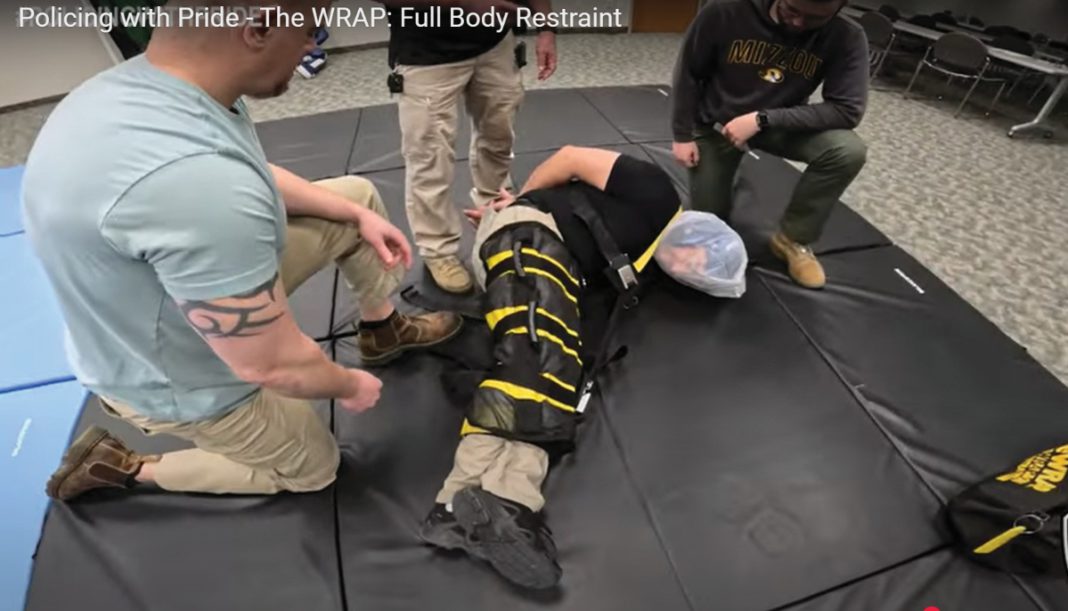Part two of a series about a Marin family, mental health and local law enforcement.
Critics liken the WRAP restraint system to a torture device and point out that it has been linked to some in-custody deaths. Proponents claim it saves lives.
Nine of Marin’s 13 law enforcement agencies use the WRAP. San Rafael, Ross, Belvedere and the College of Marin police departments do not have the device.
The WRAP, manufactured by Safety Restraints Inc., includes a locking shoulder harness, a locking carabiner to secure handcuffs to the device, a leg restraint and ankle straps. In a demonstration video on the company’s website, CEO Charles Hammond recommends using the WRAP system in conjunction with a spit hood and helmet.
During an interview with the Pacific Sun, Hammond admitted that when the WRAP is applied, “It doesn’t look pretty.” But he maintained it is a safe and pain-free method of restraining an individual during a crisis, and much better than the alternatives like oleoresin capsicum (OC) spray, also known as “pepper spray.”
“OC spray is extremely painful and restricts breathing,” Hammond said. “A Taser doesn’t feel good. Batons. Obviously, those are striking instruments, right? The old hog tie—where you handcuff somebody, tie their feet together and then tie their hands to their feet—is awful, and big people die on a regular basis.
“All of those tools that help stop the fight are all pain compliance,” he continued. “With the WRAP, there’s not pain associated with its use.”
According to Hammond, more than 2,200 law enforcement agencies and correctional facilities in the U.S., Canada and Australia have purchased 14,000 WRAP restraints. Next up, Brazil.
“They are all looking for a better way to stop a fight,” Hammond said. “In the [police] videos you watch that don’t have the WRAP, it’s yelling and screaming, ‘Stop resisting, stop resisting.’ Then the fight is on and escalates, and the punches get more heavy and more severe.”
Despite Hammond’s estimate that the WRAP is used 50,000 times each year, scientific research and data on the device’s safety are hard to come by. The manufacturer provides only anecdotal information.
A 2013 study by The Institute for the Prevention of In-Custody Death Inc. (IPICD) relied on four police departments that voluntarily submitted 128 use of force and incident reports, some of which had information redacted. The institute’s summary of findings included that “users reported The WRAP to be 100% effective,” and that no deaths or injuries were identified.
Yet, numerous coroner reports, lawsuits and media articles describe in-custody deaths involving the WRAP. As a result, some agencies have banned the device.
“We have not ever lost a lawsuit, and the WRAP has never been the sole determined cause of death when used correctly,” Hammond said. “Everything else that’s used has severe downfalls and pain compliance components to how they operate. That’s not how the WRAP operates.”
When asked about Dujuan Armstrong, who died in 2018 after being restrained in the WRAP at the Santa Rita Jail in Alameda County, Hammond said the equipment had been misused. While the coroner’s report did not comment on whether the device had been used correctly, it concluded that Armstrong died of mechanical asphyxia, attributing the cause to the position of the WRAP device and the spit mask covering his face.
“Any tool that you use, there’s still a human component there,” Hammond said of the incident. “The equipment has been used improperly, so in the video from the Santa Rita Jail, they put the harness on the neck rather than on their back. And when they put it on the neck and tightened it forward, that’s what pulled the [Armstrong’s] head forward.”
Marin resident Michael Little, who is suing the Central Marin Police Authority, Novato Police Department and Fairfax Police Department for their use of the device, believes that Armstrong’s death demonstrates the need for enforceable policies on how to use it correctly.
Little’s brother, Josh Little, was placed in the WRAP many times by the three Marin police agencies. The legal claim filed against them is for violating Government Code 7286, which states that law enforcement agencies must maintain a policy that includes “comprehensive and specific guidelines regarding approved methods and devices available for the application of force.”
During a court hearing in April, Thomas Bertrand, the attorney representing the three police agencies, disputed Little’s assertion, noting that his clients use policy manuals from Lexipol, a Texas company.
“The Lexipol policy covers all restraint devices,” Bertrand said. “It covers handcuffs; it covers the WRAP device. It mentions the WRAP device in specific places. We do not need a policy on every single type of restraint device, and the reason for that is that the manual would be so lengthy that no police officer could absorb the policies.”
Actually, the Fairfax and Novato policy manuals do not mention the WRAP restraint at all. Central Marin does have specific references to the WRAP, but only regarding how to clean and prepare it for reuse.
Bertrand declined requests to be interviewed for this article.
In Marin, only one of the nine departments with the WRAP device has a specific policy on its use—the Marin County Sheriff’s Office. Little hopes that his legal action will spur the others to follow the sheriff’s lead.
Additionally, Little raises concerns about the amount of training officers receive on the WRAP. Although it’s not an element of his lawsuit, he believes that adequate training on the device can mitigate risks.
Hammond agrees, which is one of the reasons his company provides a free two-hour training session on Zoom when an agency buys the WRAP and every two years thereafter. Training is also available upon request, he said.
“Only two hours of training for a device like that is nuts,” Little told the Pacific Sun. “It’s grossly insufficient for a device that has a known risk of positional asphyxiation and has been linked to multiple deaths. It’s totally different putting it on your training partner than on somebody having a mental health crisis in the street.”
However, Hammond stated that the WRAP is not a complicated device. And he claims that it is not a full body restraint system.
“The allegation [is] that it’s a full body restraint—really it’s a leg restraint, and the harness is not a restrictive tool or the restraint,” Hammond said. “It’s an added component to allow a person to lean back like you’ll lean back in the chair. So you can sit and relax. That’s what the shoulder harness is for.”
Interestingly, his company website, saferestraints.com, also sells the harness separately, describing it as a restraint. “If the individual became violent, a full-body restraint can be accomplished by adding the leg restraint,” according to the webpage.
Perhaps as lawsuits wend their way through the court system—either for in-custody deaths associated with the WRAP device or to demand specific policies for its use—answers will be revealed.












I would like to thank you for publishing this article Joshua Wilson little was my Gidson and I know this family very well. I’m grateful that Micheal is standing up to the folks that r putting this restraint system out there. A zoom session for training on this equipment device is not sufficient and putting someone in this contraption when they r calm and compliant is very different than when an individual is in crisis that is where the trading needs to come prior to putting g this contraption on ppl please don’t allow my godson to have perished for nothing let this be the change that needs to happen in person training zoom really
A prototype alternative to the Wrap: Cuffbar restraint system